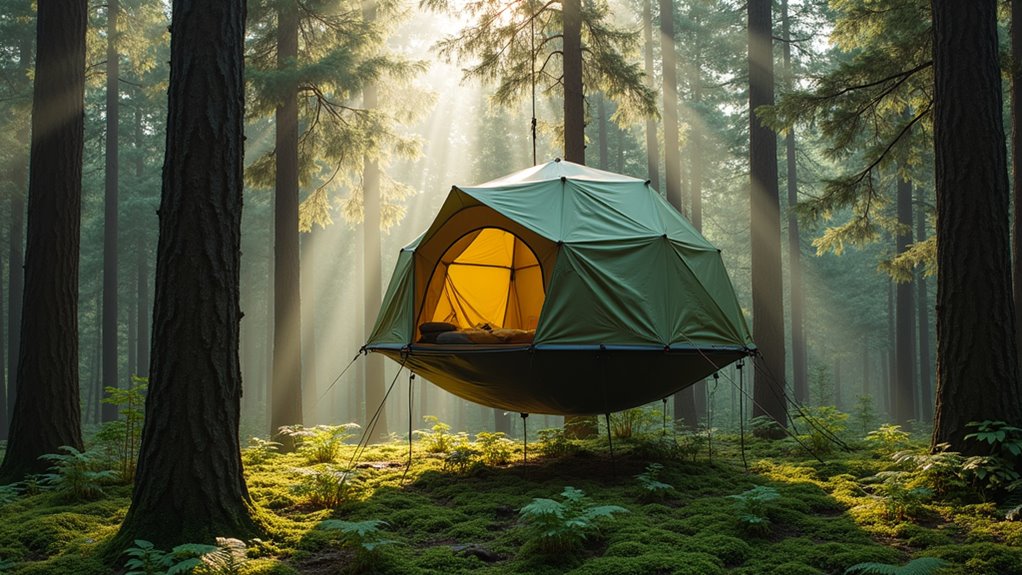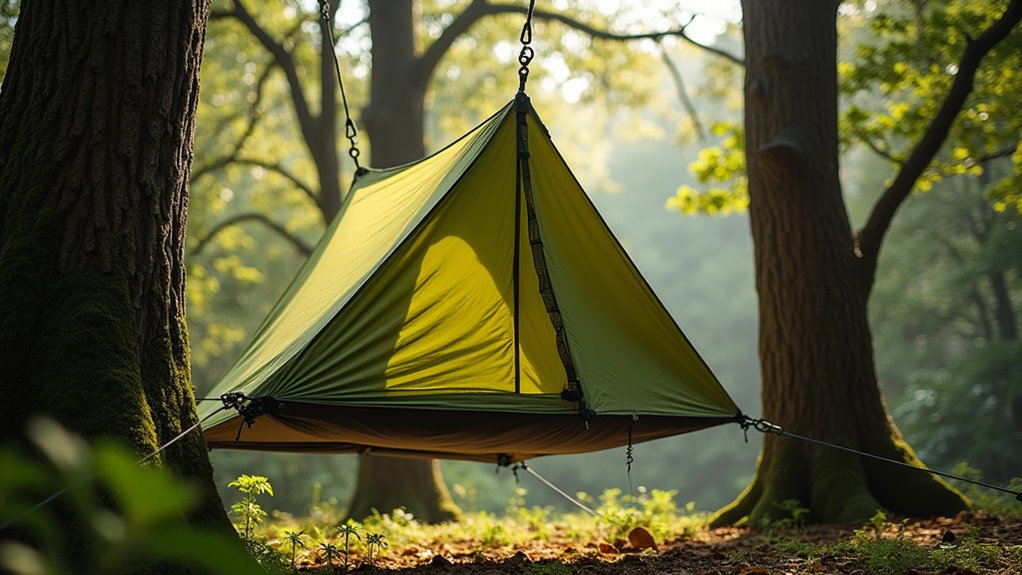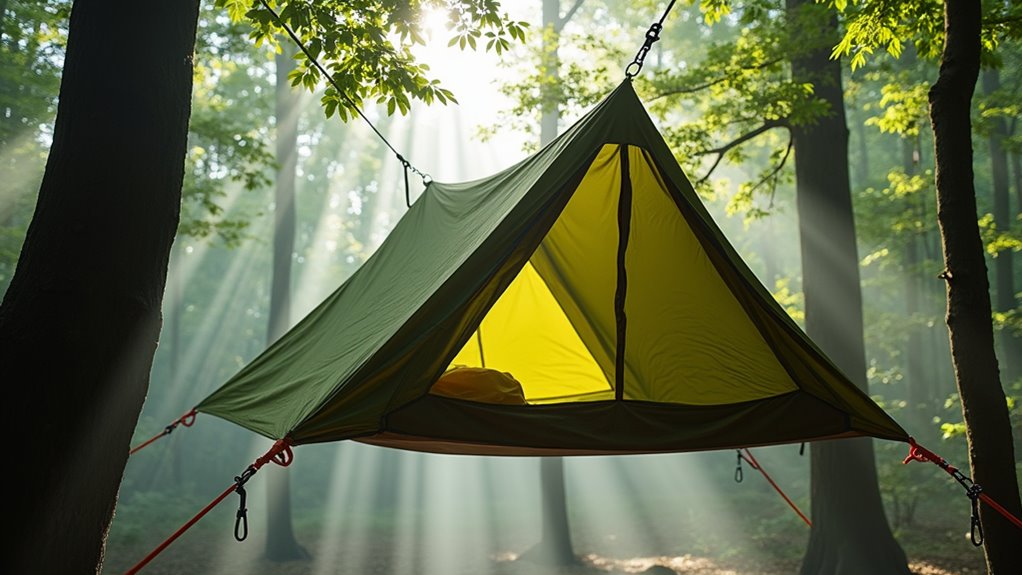Physical Address
304 North Cardinal St.
Dorchester Center, MA 02124
Physical Address
304 North Cardinal St.
Dorchester Center, MA 02124

Tree tents revolutionize forest camping by suspending you above ground—but choosing the wrong one could ruin your adventure.
You’ve probably pitched your tent on rocky ground or dealt with soggy sleeping bags after unexpected rain. Tree tents solve these common camping frustrations by lifting you above the forest floor entirely. They’re suspended between sturdy trees, creating a cozy floating shelter that keeps you dry, comfortable, and away from crawling critters. Before you dismiss them as expensive gear for extreme adventurers, you’ll want to know how affordable and practical these elevated shelters have become.

When you’re tired of sleeping on rocky ground or dealing with soggy tent floors, tree tents offer an elevated camping solution that literally lifts you above common ground-level problems. These innovative shelters suspend between three or more trees using adjustable straps and tensioning systems, creating a stable platform several feet off the ground.
You’ll set up your tree tent by wrapping heavy-duty straps around sturdy trees, then connecting the tent’s triangular or diamond-shaped frame. The tensioned fabric creates a flat sleeping surface that stays dry even during rain. Most models include built-in rainflies and bug protection.
Tree tents work best with trees spaced 12-20 feet apart and at least 6 inches in diameter. They’re perfect for uneven terrain where traditional tents won’t work. Just like underwater diving requires proper preparation and technique, setting up tree tents safely demands attention to detail and following best practices.
While traditional camping means you’re stuck with whatever the ground offers, tree tent camping puts you in control of your sleeping environment. You’ll avoid rocky terrain, wet ground, and muddy conditions that can ruin a good night’s sleep.
Sleeping suspended keeps you away from crawling insects, snakes, and other ground-dwelling creatures. You won’t need expensive sleeping pads or worry about punctures from sharp rocks or thorns underneath.
Tree tents also provide better ventilation since air circulates freely around your suspended shelter. This prevents condensation buildup that’s common in ground tents, keeping you drier and more comfortable.
You’ll have incredible views too – imagine waking up at eye level with tree canopies. Plus, you’re claiming unused vertical space, so you can camp in areas where ground space is limited or unsuitable.
These amazing tree tents offer a truly unique camping experience that transforms how you connect with forest environments.

Since tree tent camping offers such compelling advantages, you’ll want to choose the right model that matches your specific outdoor adventures and budget.
For solo adventurers on tight budgets, the Tentsile Connect offers solid construction under $300. It’s lightweight and handles one person comfortably.
Couples should consider the Tentsile Stingray, which accommodates two adults with extra gear space. It’s pricier but worth the investment for shared adventures.
Families need the spacious Tentsile Universe, sleeping up to six people. While it’s the most expensive option, it eliminates buying multiple tents.
Ultralight backpackers can’t beat the Lawson Hammock Blue Ridge, weighing just three pounds. It switches between ground and tree setup easily.
Consider your group size, weight requirements, and budget before purchasing. Each model serves different camping styles effectively.
Remember that proper tent setup is crucial for safety and comfort, regardless of which tree tent model you choose.
After selecting your ideal tree tent model, proper installation becomes your top priority for both safety and comfort. First, choose healthy trees with sturdy trunks at least 6-8 inches in diameter, spaced according to your tent’s specifications. You’ll want to inspect branches for dead wood, disease, or insect damage before setup.
Always use the manufacturer’s straps and hardware – don’t substitute with cheaper alternatives that could fail. Wrap tree straps around trunks at the recommended height, ensuring they’re level and properly tensioned. Double-check all connection points and carabiners before entering your tent.
Test the installation by gently bouncing on the platform while holding safety lines. If anything feels loose or unstable, readjust immediately. Remember, spending extra time on proper setup prevents dangerous accidents and protects your investment.
Consider bringing a portable camping toilet to ensure you have convenient bathroom facilities while elevated in your tree tent setup.

Before you even unpack your tree tent, you’ll need to scout the perfect spot that balances safety, comfort, and practicality. Look for healthy, mature trees with sturdy trunks at least 6 inches in diameter. Dead or diseased trees won’t support your weight safely.
You’ll want trees spaced 8-15 feet apart, depending on your tent’s size.
Choose level ground underneath in case you fall, and avoid areas with loose rocks or steep slopes. Check for overhead hazards like dead branches that could drop during wind or storms.
Stay away from water sources where animals gather, and respect camping regulations.
Test tree stability by pushing against trunks – they shouldn’t flex or creak. Pick a spot that’s sheltered from prevailing winds but still offers good ventilation for comfortable sleeping.
Remember that selecting a campsite involves multiple considerations beyond just finding suitable trees, including proximity to water for drinking and cooking needs.
With your perfect camping spot selected, you’ll want to pack smart accessories that make tree tent camping more comfortable without breaking the bank. A quality sleeping bag rated for expected temperatures keeps you warm without costly heating gadgets.
Pack a compact camping pillow or stuff sack filled with clothes for neck support. LED headlamps with extra batteries provide hands-free lighting while setting up camp after dark.
Bring paracord as backup for guy-lines and emergency repairs. A lightweight tarp underneath catches dropped items and creates extra weather protection.
Don’t forget a small first-aid kit, water purification tablets, and multi-tool for unexpected situations. These affordable additions transform your elevated camping experience from basic survival into genuine comfort.
For those seeking alternative accommodation ideas, consider exploring Britain’s Motorhome Show to discover mobile camping solutions that complement your tree tent adventures.
You’ll discover that tree camping isn’t just a trend—studies show suspended sleepers report 40% better sleep quality compared to ground camping. That’s because you’re avoiding rocky surfaces, moisture, and crawling critters that typically disrupt rest. With tree tents starting around $200, you’re investing in countless nights of elevated comfort without breaking the bank. Don’t let another camping trip leave you tossing and turning on the hard ground when you could be floating peacefully among the treetops.